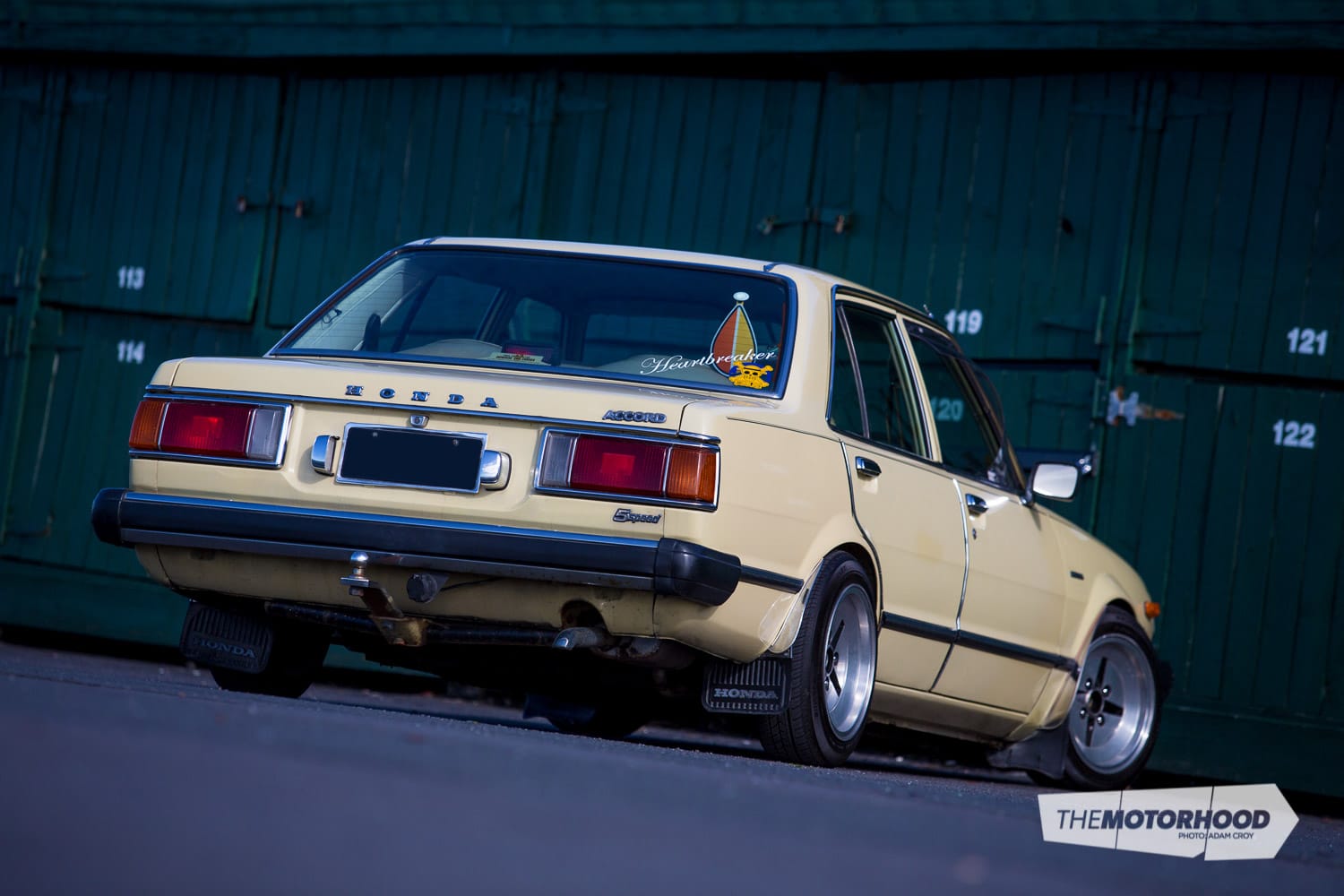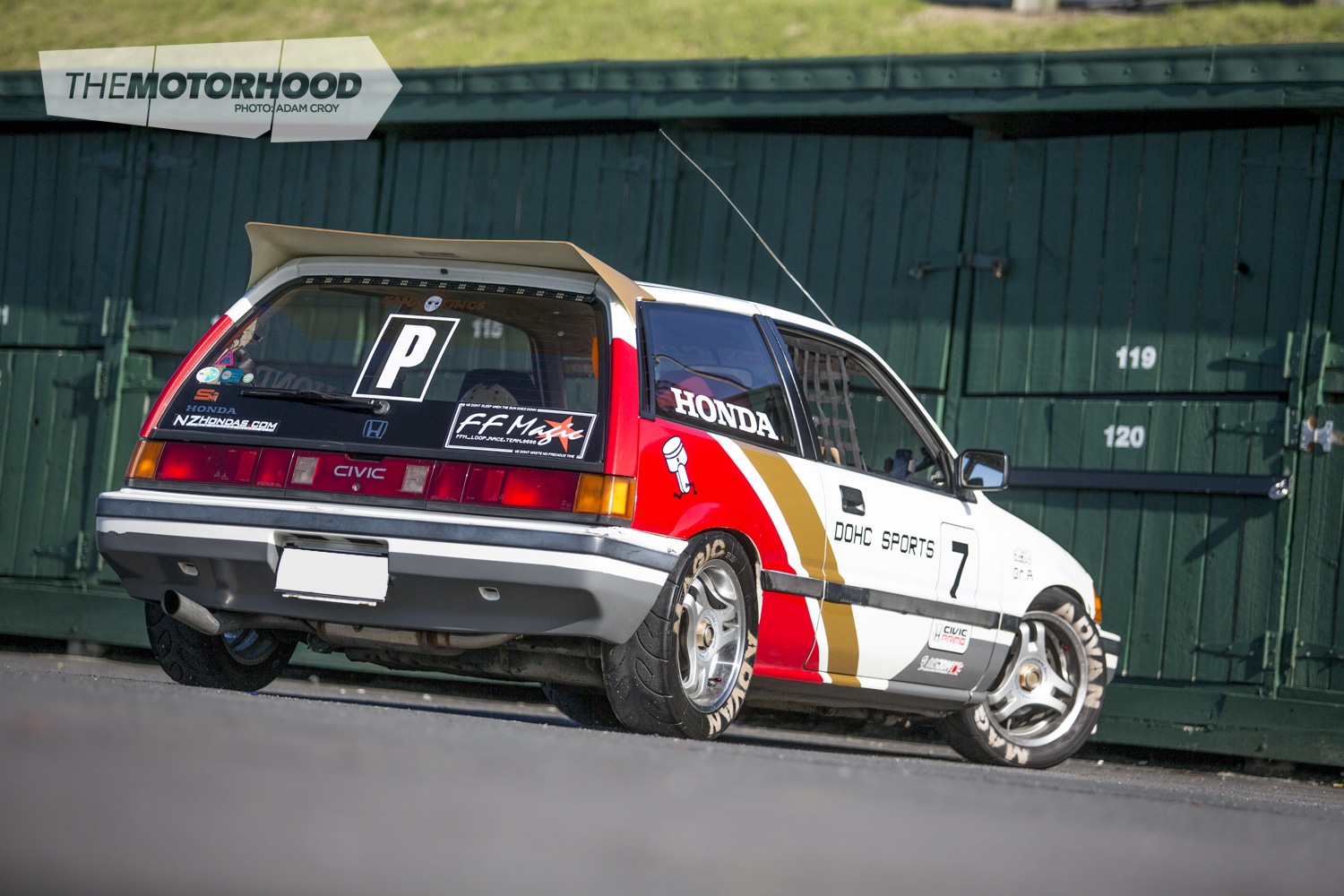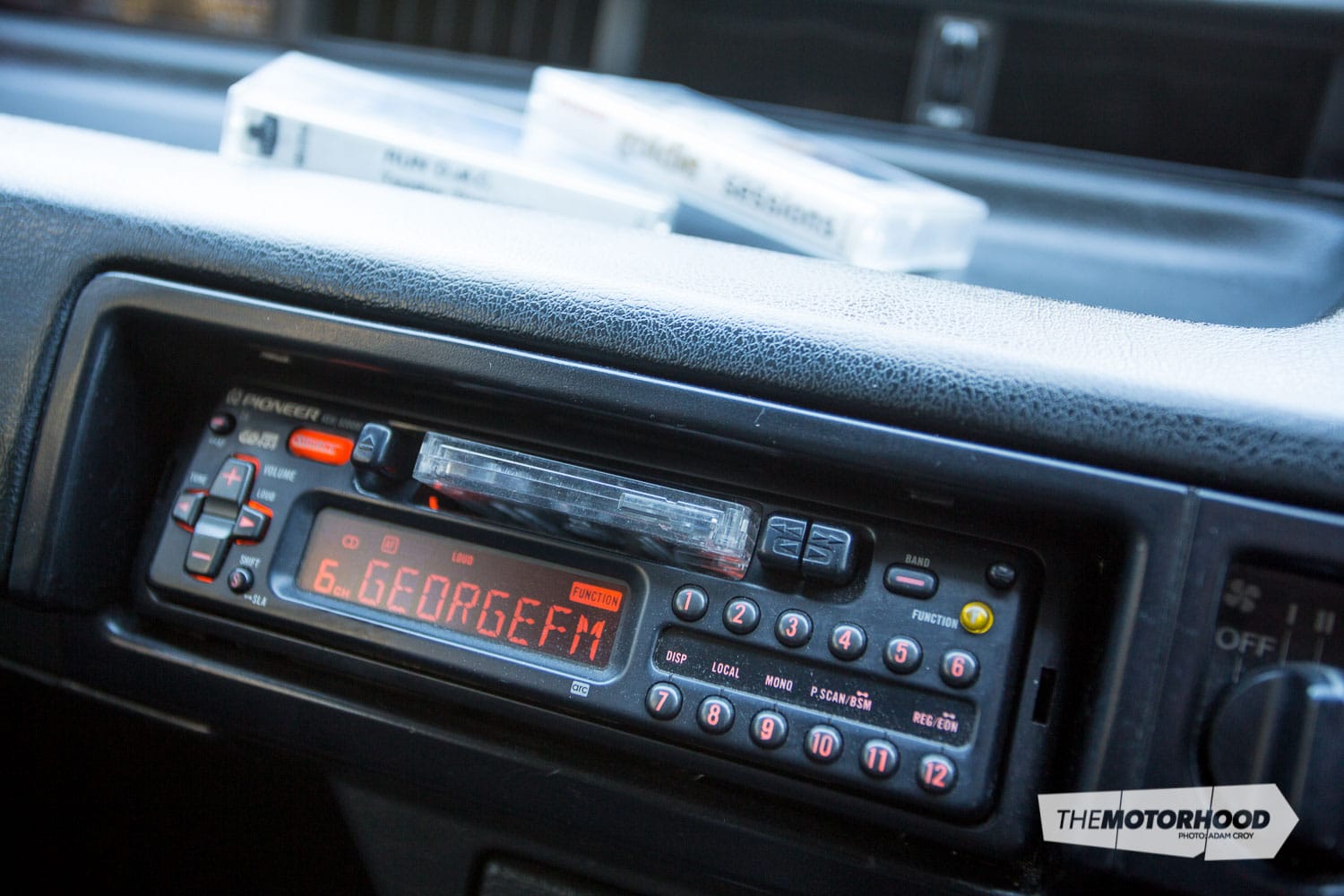data-animation-override>
“The array of Japanese nostalgic bliss tucked away under this North Shore home is as varied as a pack of liquorice allsorts, so we decided to delve deeper into the life and drive behind one of the most passionate and long-standing import enthusiasts we’ve come across”
There’s nothing better than meeting an enthusiast who has an exuberant forever-growing passion, and a garage full of iconic life-size toys built purely for black-top enjoyment — it’s an opportunity that doesn’t come around often. Nigel James, an enthusiast like no other, wouldn’t simply be satisfied with one tin-top toy, and certainly doesn’t mind the sacrifice involved in owning three petrol-powered near-classic cruisers — the time, money, and bloodshed all made worth it by the friends made, and kilometres travelled. Modifying cars came as a byproduct of being, in Nigel’s own words, a “technologically inquisitive type”, a characteristic that from a young age — and much to his parents’ dismay — saw him dismantling toys, stereos, Matchbox cars, or just about anything he could get his hands on. Sometimes they even got put back together — every last bolt, screw, and nut.

Fast forward a few years, and with a modified import scene booming around him Nigel’s Matchbox cars sooned turned into life-size examples.
“My interest in cars began the moment I realized they were modifiable. Modifying cars has always been, and will continue to be, a fascinating and satisfying pastime.” Nigel continued, “My first proper car build was a 1986 Honda Civic Si — a ZC twin-cam beast that initially won me several SPL sound-off competitions, including the 1999 4&Rotary Nationals. The Civic went from a 62kW car, to a turbocharged, custom-painted, custom-kitted 173kW street monster.”

Things didn’t turn out well for the Civic when in 2004 it was written off completely by an unlicensed Ford Falcon. This Civic was the first notch in Nigel’s tuning belt, and even helped spark the formation of New Zealand’s largest Honda community, NZHondas.com. “It (the Civic) represented the best of the late ’90s / early 2000s New Zealand car scene to me. But after eight years of Honda ownership, I decided to move onto big-bodied Toyota sedans.”
After building what is most likely one of New Zealand’s first Bosozoku style Toyota Mark IIs, which featured 10-inch wide wheels, a modified 1G-GTE engine, and barbed exhaust — a car featured in issue no. 155 — Nigel progressed onto a newer Toyota.
“In 2009 I decided to take things to a new level and try my hand at a ‘new’ car, and new style. Big-body luxury sedans and VIP cars were really influencing me, resulting in a purchase of a factory manual non-turbo 1996 Toyota Chaser,” Nigel told us.

At the time of purchase, the pick of the crop was definitely the Tourer V model, however, with a purchase price of over $19,000 it was out of Nigel’s reach, so once again he tinkered to get his way — not that he was bothered.
He had a plan to bring the Chaser to a spec higher than that of a Tourer V, so a 2JZ-GTE engine was purchased, and in no time at all — with the help of several good friends, of course — the brakes, diff, suspension, and engine were completed, and Nigel had a Chaser to surpass any Tourer V.
“After finding what I felt were the perfect wheels for the car, the final touch for the body was the purchase of a genuine Rush kit from Japan. It fits perfectly, with no modifications necessary, and with a unique shade of paint it totally changed the look of the car.”
In a typical Nigel fashion, the Chaser absolutely had to be as low as possible, yet still be driveable on long journeys. Shane Cooper, a friend working at Autolign at the time, rebuilt the Tein suspension to the best of his ability and to a spec that Nigel would be happy with. And indeed, the resulting performance is one he is more that happy with.

Building something that strays from your roots can have strange side effects, as Nigel found out near the completion of the Chaser. He told us, “Owning the newer Toyota brought light on the change that came about in the late ’90s, with technology getting in the way of pure mechanical bliss. The Chaser was the start of the era of cars that were trying to be too smart for their own good.” With these straining side effects taking their toll, Nigel prescribed himself some good ol’ fashion retail — well, vehicular retail — therapy by purchasing a 1980 Honda Accord from Wellington, sight unseen. The ’80s Accord had everything Nigel wanted in an old-school sedan from the factory, including cable-actuated central locking, oil change and tyre-rotation indicators on the dash (kilometre activated), flared guards, and aggressive twin headlights. All it needed now was combination as classic as the Accord itself — Work Equip 02s, and lowered suspension.

The car was originally meant to be K20A swapped and raced, but Nigel deemed it too tidy too cut up and tinker with. “With those wheels on, the car was complete — with nothing left to do but care for it and enjoy it. The car is full of amazing additions, it’s almost a wonder exploring everything,” Nigel told us, before revealing a build that has been almost 20 years in the making. “Of course, across this whole journey there was a matter of unfinished business from that first Civic build. I realized that not a single one of my subsequent builds was as fun as that first crazy turbocharged animal. It had always been in the back of mind — what if I got another one?”

More than a decade had passed since the original Civic was written off, and it seemed as though most of the ’80s Civic’s around the place had turned into, well, rusty piles of dust.
“After what seemed like years of searching, all of a sudden I found one, abandoned in a paddock in the South Island, waiting for its second chance.” Five years of being licked by cows, and 29 years of life, had truly taken a toll on the Civic, as Nigel found out when it was finally delivered to his home in Auckland. After coming to the realization that an army would be needed to undertake such a restoration, he posted on Facebook that he had need of a team. Shortly after, he had himself a willing and able crew of recent friends, and some old ones — all also searching for the nostalgic kicks created by such tin.

“People that hadn’t met each other before all worked with a passionate mechanical harmony, and with good humour, to bring the rusty Civic back to life. This is the epitome of what I love about modifying cars — the amazing friendships and passions it ignites in like-minded people around you. At one point I stood in the middle of the action and just looked at all the work happening — from what were complete strangers hours earlier — and realized the passion that car modifying can bring.” Nigel continued, “There may be many bad things about this scene, but if there ever was a beautiful thing, it was the scene that this decrepit, rotting hulk of a boxy Japanese toaster oven had managed to bring together.”

Nigel’s vision for the Civic was based on a creation produced on Forza Horizon, an Xbox game. The easy-to-use platform was perfect, and after hundreds of hours of playing around, he had a final template which he was able to send to the signwriters. With the build plan set in stone, parts found their way to New Zealand from every corner of the globe, including Japan, Canada, and America.
“The idea was not to rebuild the same car I had before, as once again this is a new tattoo of where I am now, influenced by the Kanjo racers of Japan, and in need of a weekend warrior,” Nigel told us. He will never forget the first time he saw his Forza creation in the metal, rather than just on his TV screen.

As the Civic was kept quiet from fellow CJC club members, he decided to debut the rebuilt Honda at the annual CJC Jerkfest — and as he drove it through the pits at Taupo, he simply blew everyone’s minds.
“Do the two Civics compare? Incredibly, despite being exactly the same year and shape of car, the two couldn’t be more different. It’s a fitting representation of who I was back then, and who I am now, and I wouldn’t have it any other way,” Nigel explained.

There’s absolutely no doubt in our minds that Nigel will grace the pages of NZ Performance Car once again in future, with a petrol-powered, bass-thumping snapshot of where he is at that point in his life. We’ll see you then, Nigel!
Driver profile
- Driver/owner: Nigel James
- Age: 30+
- Location: Auckland
- Occupation: Digital analyst
- Build time: Ages
- Length of ownership: Quite a while
- Thanks: My amazing Sara for supporting me in this non-stop adventure, Dave at Holdsworth Automotive, AJ and crew at Pit Stop, Alex at Moonlight Racing, Ben at Hunter Signs, James Tomokino from Lowcally Known, Thomas Carlos from JZX NZ, Adam at Speedscience, Shane from Slippery Gypsy Racing, John Christall at Kanjo Kings, Nathan and Dan from FFMagic, Mike and Evan from Garage Slipway, Jared Campbell, Matt SG, Antz Smith, the CJC crew, and the unstoppable Team Buffalo

Tuning menu
1986 Honda Civic Si (E-AT)
Engine
- Model: Honda ZC, 1600cc, four-cylinder
- Block: Factory
- Head: Factory
- Intake: Cold air intake
- Fuel: Walbro internal pump
- Ignition: 9mm spark plug leads
- Exhaust: 2.5-inch system, single resonator, single muffler with optional straight-pipe bypass
- Cooling: Shadow engine-temp monitor and fan controller
- ECU: Rev-limit delete
- Other: Matte champagne silk powder-coated rocker cover, glass mat deep-cycle battery
Driveline
- Gearbox: Factory five-speed
- Clutch: Exedy
- Flywheel: Lightened flywheel
- Diff: Factory
Support
- Struts: Custom Bilstein dampers front and rear (CD Accord housings) with custom valving for bump and rebound, custom shaft height, custom circlip adjustable platforms, Tein strut bushes, Cheddas Auto strut top-hat risers, Re-indexed torsion bars
- Springs: Jamex springs
- Brakes: CA Accord Si twin-pot calipers, EF7 rotors, Goodridge brake lines
- Other: Cusco strut brace, Nolathane bush kit
Shoes
- Wheels: 14×6-inch (+38) Mugen CF48 with custom aero discs (street), 15×6.5-inch (+35) Super Advan SA3R (track)
- Tyres: 185/60R14 Falken Ziex (street), 195/55R15 Advan A050 semi-slicks (track)
Exterior
- Paint: Factory
- Enhancements: Osaka JDM Evil Star AT wing, Purplespeed front lip, custom-designed JTCC inspired livery and graphics
- Other: 1200lm LED running lights, LED strip high-stop light, GT300 style tinted headlights
Interior
- Seats: Recaro SR3 driver seat, Takata four-point harness
- Steering wheel: Grip Royal, quick-release hub
- Instrumentation: Autogauge electronic oil-pressure gauge
- Other: Cheddas Auto/ Red Pepper Racing billet machined and anodized shift knob, Allstar window net
Performance
- Power: Irrelevant

Tuning menu
1996 Toyota Chaser JZX100
Engine
- Model: Toyota 2JZ-GTE, 3000cc, six-cylinder
- Block: Factory
- Head: Factory
- Intake: HKS Powermax intake
- Turbo: Factory
- BOV: HKS SSQV
- Fuel: Walbro fuel pump
- Ignition: Factory
- Exhaust: Twin two-inch secondaries from turbos, 3.5-inch exhaust system, single muffler, twin three-inch stainless steel tips
- Cooling: JZA80 Supra radiator, Ford 30-amp fans, low-temp thermo switch
- ECU: Blitz Access modified ECU
- Other: A’PEXi SAFC-II, HKS EVC3 boost controller (controls secondary turbo), TurboXS boost tap (controls primary turbo), matt champagne silk powder-coated rocker covers and intercooler piping, glass mat deep-cycle battery
Driveline
- Gearbox: Factory JZX Tourer V, five-speed
- Clutch: Exedy clutch
- Flywheels: Factory
- Diff: Cusco two-way LSD
Support
- Struts: Custom valved Tein HE Winding Master coilovers
- Springs: Tein
- Brakes: Four-pot calipers
Shoes
- Wheels: 18×9.5-inch CST Hyper Zero-1 (+22)
- Tyres: 225/40R18 Jinyu
Exterior
- Paint: Custom avocado olive, solid non-metallic
- Enhancements: Rush Japan JZX100 Chaser aero kit, Origin Labo boot spoiler, JZX100 rear under-spoiler with low-mount stop light
Interior
- Seats: Factory
- Steering wheel: OMP
- Instrumentation: Autogauge tachometer, boost gauge, and oil pressure gauge
- ICE: 3.5-inch LCD tuner with integrated rear camera, JBL GTO75 amplifier, JBL GTO 6.5-inch coaxials in all doors, JBL BP12 bandpass tuned subwoofer enclosure, SuperAutobacs crystal shift knob with colour-change LED kit
Performance
- Power: N/A

Tuning menu
1980 Honda Accord EX
Engine
- Model: Honda 1600cc, four cylinder
- Block: Factory
- Head: Factory
- Fuel: Factory single-carb
- Ignition: Factory
- Exhaust: Factory
- Cooling: Factory
- Other: Glass mat deep-cycle battery
Driveline
- Gearbox: Factory five-speed (a big deal in 1980)
- Clutch: Factory
- Flywheel: Factory
Support
- Struts: (F) Factory oil dampers shortened and converted to gas inserts (R) shortened shocks
- Springs: Compressed springs
- Brakes: Factory
Shoes
- Wheels: 14×6.5-inch Work Equip 02 Competition one-piece wheels (+4)
- Tyres: 155/65R14 tyres
Exterior
- Paint: Factory
- Enhancements: Factory flares, front lip, and monsoons
Interior
- Seats: Sheepskin seat covers
- Steering wheel: Factory
- Instrumentation: Factory with in-dash oil change / tyre rotation /filter service indicators
- ICE: Factory Sanyo cassette player and footwell speakers
- Other: Factory cigarette ash trays with illumination in all four doors, factory quartz digital rotary clock, factory cable-controlled central locking
Performance
- Power: N/A
- 0–400m: 18.7 seconds
This article was originally published in NZ Performance Car Issue No. 225. You can pick up a digital copy or a print copy of the magazine below:


























